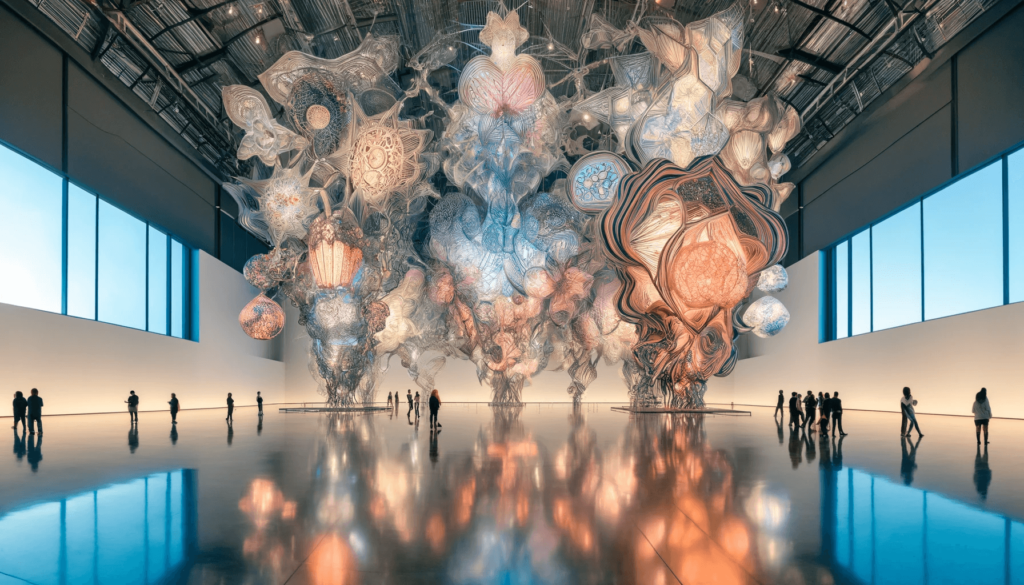
Installation art is a type of contemporary art that uses various materials and mediums to transform a space, creating an immersive experience for the viewer. This art form can be experienced in museums, galleries, or even public spaces. The main goal of installation art is to engage viewers in a unique, sensory experience, making them feel part of the artwork.
This article is designed for art enthusiasts, students, and professionals seeking to deepen their understanding of contemporary art forms.
Contents
Key Takeaways
- Installation art is a three-dimensional artistic genre that transforms spaces.
- It provides an immersive experience and can involve interactivity.
- Famous installations like Kusama’s “Infinity Mirror Rooms” and Eliasson’s “The Weather Project” are examples of its impact.
- Creating installation art involves conceptualizing, planning, gathering materials, installation, interaction, and dismantling.
What Is Installation Art?
Installation art is an artistic genre that involves creating three-dimensional works designed to transform the perception of a space. Unlike traditional art forms like painting or sculpture, installation art involves the environment in which it is displayed. It can incorporate a wide range of materials such as natural elements, everyday objects, and multimedia components like video, sound, and performance.
Key Characteristics
- Immersive Experience: Installation art surrounds the viewer, making them a part of the artwork. It’s more than just looking at a piece of art; it’s about experiencing it with all your senses.
- Use of Space: Artists use the entire space for their work. The location of the installation is as important as the artwork itself.
- Interactivity: Some installations allow or even require viewer interaction. You might walk through it, touch it, or even contribute to it.
- Temporary Nature: Many installations are temporary. They are created for a specific exhibition and dismantled afterward.
Why Important?
Installation art challenges traditional notions of art. It blurs the boundaries between art and life, encouraging viewers to engage with art in new ways. This form of art can address social, political, and environmental issues, making it a powerful medium for communication.
Examples of Famous Installation Art
- Yayoi Kusama’s “Infinity Mirror Rooms”: Kusama’s installations use mirrors and lights to create an illusion of endless space, providing a visually mesmerizing experience.
- Christo and Jeanne-Claude’s “The Gates”: This large-scale installation in Central Park involved thousands of fabric panels, creating a flowing pathway through the park.
- Olafur Eliasson’s “The Weather Project”: Displayed at Tate Modern in London, this installation featured a giant, glowing sun and mist, transforming the entire space into an atmospheric experience.
How to Create Installation Art
Creating installation art involves several steps. Here’s a simple table to outline the process:
| Step | Description |
|---|---|
| 1. Concept | Start with an idea or theme. What do you want to express? |
| 2. Planning | Decide on the materials and the space. Sketch your ideas and make a plan. |
| 3. Gather Materials | Collect everything you need. This can range from everyday objects to specialized equipment. |
| 4. Installation | Set up your artwork in the chosen space. This can take days or even weeks. |
| 5. Interaction | Consider how viewers will interact with your piece. Will they walk through it, touch it, or add to it? |
| 6. Dismantling | After the exhibition, take down the installation. Some parts may be recycled or reused. |
Why I Love Installation Art
I find installation art fascinating because it breaks away from the conventional way of experiencing art. Walking through an installation, feeling the textures, and being surrounded by the artist’s vision is incredibly exciting. It’s like stepping into a different world, one created to evoke specific emotions and thoughts. Plus, the interactive element makes it fun and engaging, even for those who might not typically enjoy traditional art forms.
Conclusion
Installation art is a dynamic and engaging form of contemporary art that transforms spaces and offers viewers an immersive experience. By using various materials and mediums, installation artists create unique works that challenge traditional notions of art and invite viewers to interact with their creations. Whether you’re an art enthusiast or just curious, experiencing installation art can be a fun and enlightening adventure.
By embracing installation art, we can explore new ways of thinking and experiencing the world around us. So next time you see an installation, dive in and enjoy the ride!